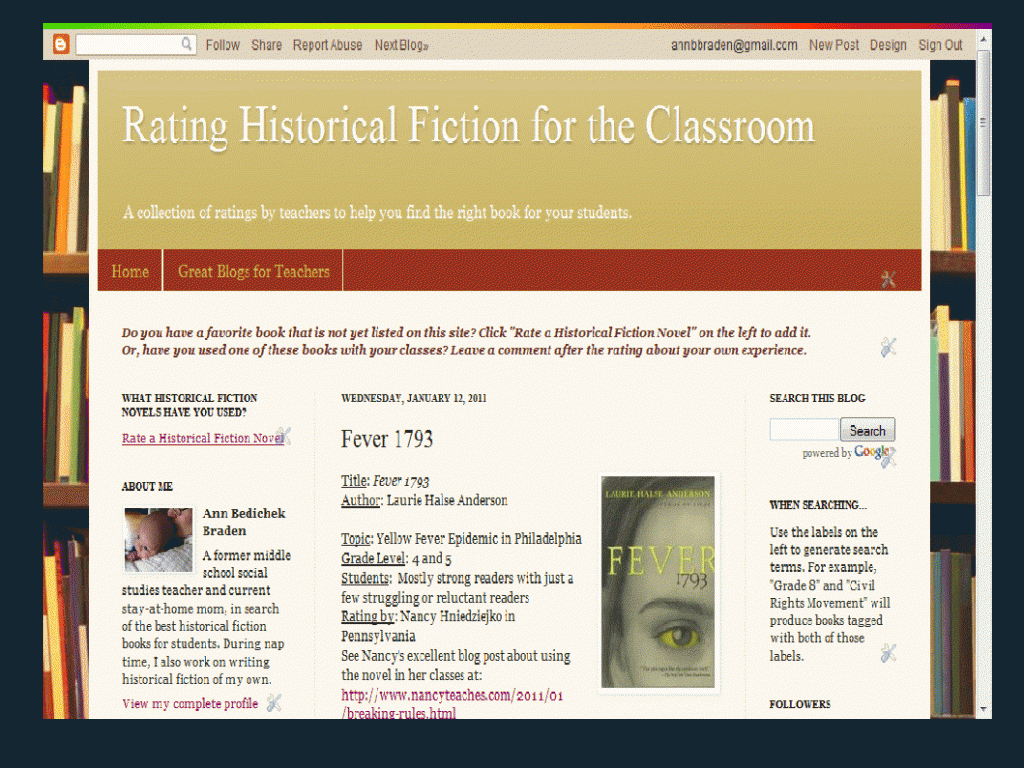I’ve been reading a lot of novels set in ancient times. It’s a way to maintain the mood and sensibility of my work-in-progress, and Ancient Greece and Rome were my favorite eras in Western Civ, way back in the day.
Writer Anne Bedichek Braden has launched an excellent website for teachers looking for good historical fiction to incorporate into their classrooms. I met Anne over at Absolute Write. She’s a former middle school teacher and currently a stay-at-home mom. She says the website is one of her writerly projects during “nap time.” She just completed a novel 1790: ON THE EDGE, which is a young adult mystery that takes place during a turbulent year when colonial Vermonters were deciding whether or not to join a fledgling country: the United States.
Anne’s inspiration for Rating Historical Fiction came from her experience in the classroom. She explains:
“When I was a social studies teacher, I loved using historical fiction in my classroom, but I rarely had time to branch out from the books I already knew. I could find lists of titles and reviews of books online, but what I really needed to know was whether a book would engage my reluctant students and if it would spark meaningful discussions in my classroom. Now that I’m a stay-at-home mom I have more time (amazing, eh?), so I started this blog to make it easier for busy teachers to find books that will work with their students. Also, it’s good for me because as a writer of historical fiction I’m intent on reading as much as I can in the genre, and since the blog collects reviews of others’ favorite books, I’ve already gotten some excellent recommendations.”
For me, historical fiction assignments in middle and high school were hits and misses. I loved Charles Dickens’ A TALE OF TWO CITIES, hated Stephen Crane’s THE RED BADGE OF COURAGE (as I recall, my book report was based on Cliff Notes), and was fairly apathetic about social studies staple INHERIT THE WIND (though it was the source of many witty fart jokes). Promoting more recent, ‘relatable’ books is part of the plan for Anne’s site.
“Most teachers are familiar with the classics, but not as many know about the great books that are being published today. I’m hoping I can collect reviews from teachers who are using recently published books and couple it with an interview of the author. ”
So far, Rating Historical Fiction has reviews of Howard Bahr’s Civil War-story THE JUDAS FIELD; Mildred Taylor’s Depression era/African American coming-of-age ROLL OF THUNDER, HEAR ME CRY; and Laurie Halse Anderson’s FEVER 1793 about the 18th century Yellow Fever epidemic in Philadelphia, just to name a few. There are also first person accounts of the Holocaust, the Korean War, and the Cambodian Genocide.
Current titles lean toward U.S. history, and the 20th century particularly, but when I was given the opportunity to contribute, I quickly submitted a review of Annabel Lyon’s THE GOLDEN MEAN. This is an absolutely fantastic book narrated by Aristotle during the period when he tutored the young Alexander the Great. While highly sophisticated in language and content, I thought it was a great resource for advanced high school students and certainly those in college. You can check out my review here.


